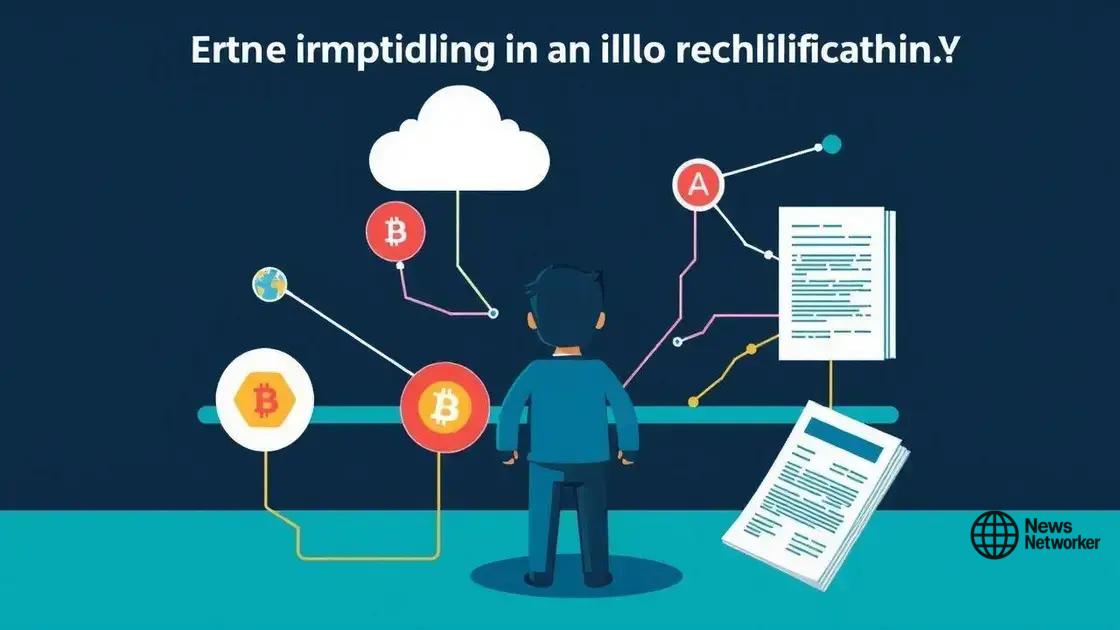Blockchain-based bond issuance policy: a game changer

A blockchain-based bond issuance policy enhances efficiency, security, and transparency in the financial market, allowing for real-time tracking, reduced costs, and streamlined processes through technologies like smart contracts.
Blockchain-based bond issuance policy is changing the finance landscape in ways we never imagined. But what does this mean for investors and issuers alike? Let’s dive into the details.
Understanding blockchain technology
Understanding blockchain technology can seem complex, but it’s actually quite fascinating. At its core, blockchain is a decentralized digital ledger that records transactions across many computers. This ensures that the recorded information cannot be altered retroactively, giving it a high level of security and transparency.
Key Features of Blockchain
The unique features of blockchain technology make it an attractive solution for many industries. Some of these key features include:
- Decentralization: No single entity controls the entire blockchain.
- Transparency: All participants have access to the same information.
- Immutability: Once recorded, data cannot be changed or deleted.
- Security: Transactions are encrypted, ensuring data safety.
This combination of features allows blockchain to support a wide range of applications, from cryptocurrencies to supply chain management. As organizations and governments explore these options, understanding the underlying technology becomes vital.
How Blockchain Works
At its simplest, a blockchain is composed of a series of blocks. Each block holds a group of transactions, tied together by cryptographic hashes. When a block is filled, it is connected to the previous block, forming a continuous chain. This chain of blocks provides a historical record of all transactions and is key to achieving transparency and trust among users.
In addition, every participant in the network can validate transactions, ensuring that they are not fraudulent. This peer-to-peer verification process is what makes blockchain such a revolutionary technology.
As we explore the world of finance, especially in areas like bond issuance, embracing blockchain technology will be crucial for staying competitive and efficient.
Benefits of blockchain in bond issuance
The benefits of blockchain in bond issuance are transforming how bonds are handled in the financial market. This innovative technology streamlines processes, making them faster and more secure. With blockchain, many tedious tasks that used to take days can now be completed in just minutes.
Increased Efficiency
One of the core advantages of using blockchain is efficiency. Traditional bond issuance involves multiple intermediaries, which can slow down the entire process. By utilizing a decentralized network, blockchain eliminates the need for middlemen. This simplification leads to quicker transaction times and lowers costs.
- Speed: Speed up the issuance process.
- Reduced Costs: Cut down on fees associated with intermediaries.
- Automation: Use smart contracts for automatic execution of terms.
- Global Access: Facilitate international investments easily.
Blockchain also promotes trust and transparency among participants. Every transaction on the blockchain is traceable, which means all parties can verify transactions without relying on third-party validations. This level of transparency not only enhances trust but also encourages broader participation.
Enhanced Security
Security is another significant benefit of blockchain technology. Data stored on the blockchain is encrypted and distributed across a vast network of computers. This makes it nearly impossible for hackers to alter any information. As a result, the risk of fraud is greatly reduced, giving investors peace of mind.
Moreover, with real-time tracking capabilities, issuers can closely monitor their bonds’ performance and ensure compliance with regulations. This continuous oversight helps identify potential issues before they escalate, ensuring that all operations run smoothly.
By embracing these advantages, organizations can significantly improve their bond issuance processes and ultimately gain a competitive edge in the financial marketplace.
Key challenges in implementing blockchain

Implementing blockchain technology comes with several challenges that organizations need to address. Although the benefits are substantial, the road to adoption can be complicated. Understanding these challenges helps in navigating the implementation process effectively.
Scalability Issues
One major challenge is scalability. As more users join a blockchain network, the system faces increased demand. This can slow down transaction processing times and lead to higher fees. Many organizations are working on solutions to enhance scalability without sacrificing security.
- Transaction speed: Slower than traditional systems during high demand.
- Network congestion: Too many transactions can overwhelm the system.
- Resource requirements: Increased computational power needed to manage more users.
Another significant hurdle is regulatory compliance. Different regions have different laws regarding blockchain and cryptocurrencies. Many organizations fear regulatory issues will hinder their operations. Clear guidelines and standards have not yet been established, making it difficult for companies to navigate the legal landscape.
Technological Integration
Integrating blockchain with existing systems poses another challenge. Many organizations still rely on traditional legacy systems. Transitioning to a blockchain-based solution requires significant investment in time and resources. Organizations must invest in training and adapting their infrastructure, which can be cumbersome.
Moreover, there is the issue of interoperability. Numerous blockchain platforms exist, often working on different protocols. Achieving seamless communication between these systems is essential for maximizing the technology’s benefits. Finding common ground for collaboration remains a complex task.
Lastly, there’s a general lack of understanding about blockchain technology among stakeholders. Many potential users struggle to see its value or how it works. This knowledge gap can lead to resistance against adopting such a transformative technology. Overcoming these hurdles is crucial for realizing the full potential of blockchain in various industries.
Future trends in blockchain bond policies
The future trends in blockchain bond policies show a promising shift towards increased efficiency and transparency in the finance sector. As more organizations recognize the advantages of blockchain, its implementation in bond issuance is likely to grow rapidly. This shift will not only change how bonds are issued but also redefine how transactions are recorded and verified.
Adoption of Smart Contracts
One of the most significant trends is the use of smart contracts. These self-executing contracts automatically enforce the terms of the agreement once conditions are met. By minimizing the need for intermediaries, smart contracts streamline processes and reduce costs. This evolution means that bond issuers can simplify their workflows and enhance operational efficiency.
- Automated processes: Smart contracts enable automatic execution of transactions.
- Reduced errors: Less human intervention means fewer mistakes.
- Cost-effective: Savings from eliminating intermediaries.
- Speed: Expedites the entire bond issuance process.
As blockchain technologies continue to advance, we may see increased regulatory support as well. Governments and regulatory bodies are beginning to understand the benefits and mechanisms of blockchain. This acceptance will likely lead to clearer regulations, encouraging more companies to adopt blockchain for bond issuance.
Interoperability Between Blockchains
Another trend is the focus on interoperability between different blockchain platforms. Ensuring that various blockchain systems can communicate effectively is essential for maximizing their potential. This capability will allow investors and issuers to engage seamlessly across multiple platforms, fostering a more integrated financial ecosystem.
The emphasis on sustainability is also becoming increasingly important. As the financial sector moves forward, green bonds and sustainable investments are gaining traction. Blockchain can provide transparency and traceability in these investments, assuring investors that funds are used appropriately. This focus will likely lead to innovations in how sustainable bonds are issued and tracked.
With these trends, the future of blockchain bond policies looks promising. Embracing these advancements will help transform the financial landscape, making it more efficient, transparent, and sustainable for all stakeholders involved.
Case studies of successful implementations
Examining case studies of successful implementations of blockchain in bond issuance reveals the transformative potential of this technology in the finance sector. These real-world examples illustrate how organizations are leveraging blockchain to streamline their operations, increase transparency, and reduce costs.
Case Study 1: World Bank’s Bond-i
The World Bank launched a bond called Bond-i, which stands for Blockchain Offered New Debt Instrument. It was issued on the Ethereum blockchain, becoming the first bond ever to be created and managed using blockchain technology. This bond raised over $110 million in Australian dollars. By utilizing blockchain, the World Bank was able to enhance transparency, enabling investors to track the bond’s lifecycle in real-time.
- Efficiency: Shortened settlement time from days to minutes.
- Transparency: Investors can easily monitor their investment.
- Cost Savings: Reduced cost related to intermediaries.
This innovative approach not only attracted attention but also set a precedent for future issuances in the bond market.
Case Study 2: Societe Generale
Another notable implementation is from Societe Generale, which issued a €100 million bond on the blockchain. This issuance showcased how financial institutions could integrate blockchain technology into traditional bond markets. Societe Generale’s bond was successfully issued in a two-day timeframe, demonstrating the potential to streamline bond issuance significantly.
By leveraging blockchain, Societe Generale reduced the need for multiple intermediaries, enhancing efficiency while maintaining a high level of security. The bank’s use of blockchain technology underscores how established financial institutions can adopt innovative solutions to remain competitive.
Case Study 3: HSBC and the T2S Project
HSBC participated in the T2S (Target2-Securities) project, which aimed to improve cross-border settlement efficiency. Through the use of blockchain, HSBC was able to facilitate a faster and more secure settlement process for its bond transactions. This illustrated how blockchain could bridge gaps between various financial systems.
These case studies emphasize the positive impact of blockchain on bond issuance. As more organizations recognize the potential benefits, the adoption of this technology in the bond market is expected to grow, leading to more innovative solutions and practices.
In conclusion, the implementation of blockchain technology in bond issuance offers exciting possibilities for the future of finance. It enhances efficiency, improves transparency, and boosts security while meeting the demands of a modern market. With successful case studies demonstrating these advantages, more companies are expected to adopt blockchain solutions. As we move forward, embracing these advancements will be crucial for staying competitive in the rapidly evolving financial landscape.
FAQ – Frequently Asked Questions about Blockchain-based Bond Issuance
What is blockchain technology?
Blockchain technology is a decentralized digital ledger that records transactions across multiple computers, ensuring data integrity and security.
How does blockchain improve bond issuance?
Blockchain streamlines the issuance process by enhancing efficiency, reducing costs, and providing transparency for all participants.
What are smart contracts?
Smart contracts are self-executing contracts with the agreement terms directly written into code, allowing for automatic execution without intermediaries.
Can you give an example of a successful implementation?
One example is the World Bank’s Bond-i, the first bond issued on the blockchain, which raised funds while providing real-time tracking for investors.





